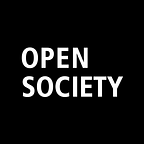A Revolution in Roma Representation
Recently, work by the artist and Open Society Foundations Community Youth Fellow Joci Marton’s was featured in a Hungarian edition of ELLE. Open Society Program Officer Zachary Turk spoke with Marton about the Roma LGBTI community, media representation, and what happens when people from marginalized groups decide to control their own narratives.
To start, would you tell us a bit about your photograph in ELLE?
It was inspired by a childhood memory of mine-the first time I can remember experiencing shame for not adhering to gender norms.
When I was a small child, I loved to dance in my grandmother’s skirt while listening to my favorite music. One time, though, I stepped on the skirt and tripped and hit my head on a nearby table. It was bad enough that my parents had to take me to the doctor. And when I heard my parents discussing the accident, I realized that, according to the adult world, there was something “wrong” with me for wearing the skirt.
Is that why you’re wearing a skirt in the photo?
Yes. That photoshoot was the first time since then that I’d worn one. So, I wanted the self-portrait to represent that aspect of childhood, when we learn about all the expectations other people have placed on us because of our gender. It seemed to me like something that many, many people-not just LGBTI Roma-could relate to.
How do you think about the relationship between LGBTI Roma representation and social change?
There is a lack of representation of Roma LGBTI people in the media-and what little there is does not depict us as we really are. That’s what’s motivating people to change the narrative through visual self-representation.
Without denying the difficulties LGBTI Roma face in society, we want to show that we are also beautiful and strong. For the sake of truth as well as empowerment, we need room to show other aspects of our identities.
Why self-portraits?
I think that when you make sure that individuals from marginalized communities get to decide for themselves how they want to be seen, what you’ll end up with will have much more dignity and gravitas than would otherwise be the case.
Put simply, nobody wants to see photos of themselves in which they look powerless and pathetic. The only reason that that happens-and is considered so normal-is because of how often those who are not part of the LGBTI Roma community are controlling how we’re depicted.
What do you hope to inspire in others through your work?
I hope that people realize that the Roma LGBTI community is extremely diverse, and that our diverse experiences make it so we have a lot to tell about and offer to the rest of the world.
But our messages are not limited to the LGBTI Roma community; we also fight against racism, misogyny, fat-shaming, and toxic masculinity. We’re creating for our community, yes, but we’re also trying to expand our reach and incorporate the experiences of all kinds of people.
This post was originally published at https://www.opensocietyfoundations.org. For more Open Society voices, subscribe to our email updates.
